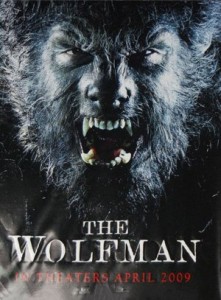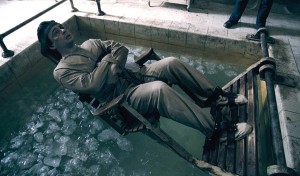 I recently had an opportunity to watch The Wolfman (2010). It was a film I had been looking forward to seeing as a new version of a Universal Studios horror classic. I did not find it very satisfying, but it did include some interesting elements and food for thought.
I recently had an opportunity to watch The Wolfman (2010). It was a film I had been looking forward to seeing as a new version of a Universal Studios horror classic. I did not find it very satisfying, but it did include some interesting elements and food for thought.
Like the 1941 version of the film starring Lon Chaney, Jr., the current version tells the story of Lawrence Talbot (Benicio Del Toro) who responds to the pleas of Gwen Conliffe (Emily Blunt), his late brother’s fiancée, in returning to the family estate in England in an attempt to discover the cause of his brother’s brutal death. His return home brings Lawrence face to face with his estranged father, Sir John Talbot (Anthony Hopkins), that he has not seen for years. As Lawrence investigates the strange and grisly circumstances surrounding his brother’s death he soon finds that it is connected to a vicious beast stalking the countryside, which may have a long connection to the Talbot family and Lawrence’s lifelong nightmares and tensions with his father.
When I first heard the announcement of this film’s production I was cautiously optimistic. It was good to hear of an attempted return to the iconic monsters of old and a move in horror away from our current fixations on “torture-porn” and slasher films, but with the current state of horror I was wary that a good film could be made, and one that would appeal to modern audiences. Sadly, my fears played out. On the positive side, The Wolfman includes some elements that I enjoyed, including a shift away from a contemporary setting to the “foreign” settings of horror in the days of Universal’s classics. The makeup effects under the leadership of Rick Baker were outstanding, as were some of the CGI effects in the recreation of nineteenth century England. But beyond this specific elements of the film were lacking, leading to an overall dissatisfaction withe project as a whole. The CGI effects related to the werewolf were not convincing, and more attention should have been paid to this key aspect of the film or it should have been abandoned in favor of makeup and prosthetic effects. I also found the concluding element of the story’s narrative disappointing in pitting werewolf-cursed father against son in a lycan battle to the death.

But even with an overall disappointment with this film I did find one element of particular interest. As Lawrence comes to terms with his curse he eventually comes to realize that his father shares it with him. Indeed, it was his father who killed his brother and mother, and bit Lawrence creating the next generation of the werewolf. As part of this unfolding revelation, in one scene Sir John shows Lawrence a room which includes a restraining chair and a memorial to his wife. Sir John explains that he was driven by guilt over his curse and the murder of his wife to restrain himself with each full moon so that he could not go on killing sprees. But eventually, Sir John came to embrace his curse and the violence that goes with it. He hopes that his son, struggling with the reality of his uncontrollable violent nature, will as well. As he says to Lawrence, “The beast will have its day. The beast will out.”
In past depictions of the werewolf the focus has been on human beings who lose control as they are transformed and consumed by an inner monstrousness. Little interest has been shown by the cursed individual in attempting to control the monster. But as time goes more more reflection has taken place on understanding the werewolf as a metaphor for our inner evil selves, and with it has come the occasional depiction of attempts to control this evil. For example, in Buffy the Vampire Slayer the character Oz (Seth Green) is a werewolf who locks himself away each cycle of the full moon so that he cannot harm others. Oz recognizes his inner beast but takes steps to control and contain it. In similar fashion, The Wolfman raises the specter of humanity’s inner beast and presents us with the choice of reveling in the beast’s ability to destroy, or taking whatever steps are necessary to control it.
News broadcasts demonstrate each day that our beasts roam all too freely. But films like The Wolfman remind us that we have a choice and we must constantly ask ourselves individually and collectively, must the beast have its day?





I totally agree. The movie was a dud.
I was excited to see the first Puerto Rican Werewolf but Benicio Del Toro performance was uninspiring.
You would think with a theme of “Controlling the inner Monster” that the actors would have enough motivation to shine. I’m obsessed with this theme and am working on a Horror-Comedy novel with it as a sub-theme.
Another way the character “Oz” from Buffy the Vampire Slayer controlled his “inner Monster” was by going to the Orient and learning the mystery arts of Transcendental Meditation the same way that the Incredible Hulk did in the new movie. Very powerful when done right. If the Horror genre is ever going to be relevant again they have to get back to its foundation: Our fears of “Transformation” and the “Supernatural”. That is the realm of religion!!
The movie had a good look and feel at the outset. Despite being a fan of the monster, the three central actors and a real desire to like this movie, it just fell flat for me. I really didn’t care for the father vs son aspect.
Yes, I was disappointed too. The CGI during the transformations was poor, but the London romp was exciting. The dynamic of the movie removes the pivotal role of Talbot as innocent facing unstoppable doom. The father/son curse gimmick is typical Hollywood rethink.
You bring up a fascinating topic: “we have a choice and we must constantly ask ourselves individually and collectively, must the beast have its day?” Recent times have seen a marked increase in people of position and power losing their ability to restrain themselves, causing them to act in an uncivil manner and thoughtlessly. This is something to explore and ponder.
I’m pleasantly surprised by the posting of comments on this topic. I really didn’t think my take on this would resonate with many in the blogosphere. John, I’m glad you found the issue I raised in the conclusion of my post of interest. This film raises the question, and I think it’s an ongoing one in certain expressions of horror, such as in Jekyll and Hyde, and in some ways The Picture of Dorian Grey. What to do with our beast? Project it, as in Dorian Grey, let it run unbridled and revel in it, as in the latest Wolf Man, or restrain/contain it in some way?
First, “The Picture of Dorian Gray” is just a masterpiece!!
Second, “What to do with our beast?” is this generations Big Question. We are at a point in time were we have accepted that there is an “Inner Beast” and the Pop Culture is just expressing that reality. (From the Superhero genre, horror and whatever the Twilight Saga is!!)
Evil is now under the microscope. No longer is Evil out there, or the Other, but lurking in our mist and even in us!! The Wolfman could have been a better movie but I think maybe that the masses understanding of the “Inner Beast” has become more sophisticated than you can show in the classic wolfman.
They want to dig deeper were the classic wolf man only explore the surface!! I think this is going to be the problem with all of the classic Horror remakes!! Each generation needs its own horror stories built on the foundation of the classics.